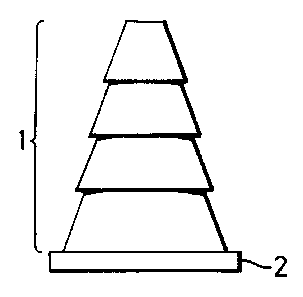Some of the information on this Web page has been provided by external sources. The Government of Canada is not responsible for the accuracy, reliability or currency of the information supplied by external sources. Users wishing to rely upon this information should consult directly with the source of the information. Content provided by external sources is not subject to official languages, privacy and accessibility requirements.
Any discrepancies in the text and image of the Claims and Abstract are due to differing posting times. Text of the Claims and Abstract are posted:
| (12) Patent: | (11) CA 2179085 |
|---|---|
| (54) English Title: | SURGICAL PINS |
| (54) French Title: | BROCHES CHIRURGICALES |
| Status: | Term Expired - Post Grant Beyond Limit |
| (51) International Patent Classification (IPC): |
|
|---|---|
| (72) Inventors : |
|
| (73) Owners : |
|
| (71) Applicants : |
|
| (74) Agent: | NORTON ROSE FULBRIGHT CANADA LLP/S.E.N.C.R.L., S.R.L. |
| (74) Associate agent: | |
| (45) Issued: | 2006-12-05 |
| (22) Filed Date: | 1996-06-13 |
| (41) Open to Public Inspection: | 1996-12-16 |
| Examination requested: | 2003-06-09 |
| Availability of licence: | N/A |
| Dedicated to the Public: | N/A |
| (25) Language of filing: | English |
| Patent Cooperation Treaty (PCT): | No |
|---|
| (30) Application Priority Data: | ||||||
|---|---|---|---|---|---|---|
|
A pin for attaching a surgical membrane barrier to tissue structure of a patient comprises a pin body 1 formed from a sequence of four truncated cones which define a serrated profile which enables the pin to engage the membrane barrier and to be pushed-fitted into the tissue structure. The head portion 2 of the pin serves to engage the membrane barrier and retain it in position on the underlying tissue structure. The pin is made from a resorbable polymer, such as PDS Polydioxanone and is of substantially solid construction throughout. In an alternative embodiment, a circularly cylindrical extension is provided between the largest truncated cone and the pin head. The arrangement serves to maintain a spacing between the membrane barrier and the underlying tissue.
Broche pour attacher une barrière de membrane chirurgicale à une structure de tissu d'un patient comprenant un corps de broche 1 formé d'une séquence de quatre cônes tronqués qui définissent un profil dentelé qui permet à la broche d'enclencher la barrière de membrane et d'être poussé-engagé dans la structure de tissu. La portion de tête 2 de la broche sert à enclencher la barrière de membrane et à la garder en position sur la structure de tissu sous-jacente. La broche est faite d'un polymère résorbable, tel le polydioxanone PDS et d'une construction substantiellement solide. Dans un mode de réalisation alternatif, une extension cylindrique circulaire est prévue entre le cône tronqué le plus grand et la tête de broche. Les arrangements servent à maintenir un espace entre la barrière de membrane et le tissu sous-jacent.
Note: Claims are shown in the official language in which they were submitted.
Note: Descriptions are shown in the official language in which they were submitted.

2024-08-01:As part of the Next Generation Patents (NGP) transition, the Canadian Patents Database (CPD) now contains a more detailed Event History, which replicates the Event Log of our new back-office solution.
Please note that "Inactive:" events refers to events no longer in use in our new back-office solution.
For a clearer understanding of the status of the application/patent presented on this page, the site Disclaimer , as well as the definitions for Patent , Event History , Maintenance Fee and Payment History should be consulted.
| Description | Date |
|---|---|
| Inactive: Expired (new Act pat) | 2016-06-13 |
| Grant by Issuance | 2006-12-05 |
| Inactive: Cover page published | 2006-12-04 |
| Inactive: Final fee received | 2006-09-15 |
| Pre-grant | 2006-09-15 |
| Letter Sent | 2006-04-13 |
| Notice of Allowance is Issued | 2006-04-13 |
| Notice of Allowance is Issued | 2006-04-13 |
| Inactive: IPC removed | 2006-04-10 |
| Inactive: IPC removed | 2006-04-10 |
| Inactive: IPC from MCD | 2006-03-12 |
| Inactive: IPC from MCD | 2006-03-12 |
| Inactive: IPC from MCD | 2006-03-12 |
| Inactive: IPC from MCD | 2006-03-12 |
| Inactive: Approved for allowance (AFA) | 2006-01-11 |
| Amendment Received - Voluntary Amendment | 2005-12-15 |
| Inactive: S.30(2) Rules - Examiner requisition | 2005-06-20 |
| Inactive: Application prosecuted on TS as of Log entry date | 2003-07-17 |
| Letter Sent | 2003-07-17 |
| Inactive: Status info is complete as of Log entry date | 2003-07-17 |
| All Requirements for Examination Determined Compliant | 2003-06-09 |
| Request for Examination Requirements Determined Compliant | 2003-06-09 |
| Amendment Received - Voluntary Amendment | 2003-06-09 |
| Application Published (Open to Public Inspection) | 1996-12-16 |
There is no abandonment history.
The last payment was received on 2006-06-09
Note : If the full payment has not been received on or before the date indicated, a further fee may be required which may be one of the following
Patent fees are adjusted on the 1st of January every year. The amounts above are the current amounts if received by December 31 of the current year.
Please refer to the CIPO
Patent Fees
web page to see all current fee amounts.
Note: Records showing the ownership history in alphabetical order.
| Current Owners on Record |
|---|
| ETHICON, INC. |
| Past Owners on Record |
|---|
| KENNETH ROBERT ANDERSON |
| RALPH PAUL DAY |